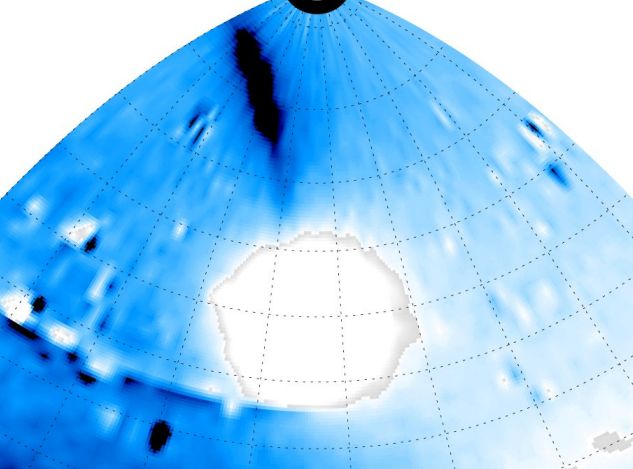Explanation: Hale-Bopp, the Great Comet of 1997, may have been the most viewed comet in history - visible even from bright metropolitan skies. Astronomers are now reporting that this magnificent comet also cast a shadow against the glare of the solar system's ultraviolet haze. This false-color image represents a slice of the sky viewed by the SWAN (Solar Wind ANisotropy) instrument aboard the space-based SOHO observatory. Recorded on March 8, 1997 it shows a general haze of solar ultraviolet light scattered by interstellar hydrogen. The sun itself is positioned below the bottom center of the cropped image and the large bright spot is ultraviolet sunlight scattered by the cloud of hydrogen gas surrounding Hale-Bopp's nucleus. Just above and to the left is a broad, diffuse, dark streak - the 150 million kilometer long shadow produced by the denser regions of this hydrogen envelope. Why are comets surrounded by hydrogen? The hydrogen comes from the breakup of water (H20) vapor released as the comet nucleus approaches the sun. These observations indicate that Hale-Bopp's nucleus was producing about 300 tons of water per second.
1999 2000 2001 2002 2003 2004 2005 2006 2007 2008 2009 2010 2011 2012 2013 2014 2015 2016 2017 2018 2019 2020 2021 2022 2023 2024 2025 |
Yanvar' Fevral' Mart Aprel' Mai Iyun' Iyul' Avgust Sentyabr' Oktyabr' Noyabr' Dekabr' |
NASA Web Site Statements, Warnings, and Disclaimers
NASA Official: Jay Norris. Specific rights apply.
A service of: LHEA at NASA / GSFC
& Michigan Tech. U.
|
Publikacii s klyuchevymi slovami:
comet - hydrogen - Comet Hale-Bopp - kometa Heila-Boppa - yadro komety
Publikacii so slovami: comet - hydrogen - Comet Hale-Bopp - kometa Heila-Boppa - yadro komety | |
Sm. takzhe:
Vse publikacii na tu zhe temu >> | |
